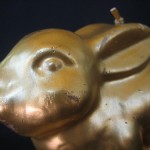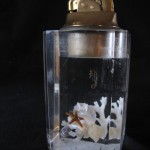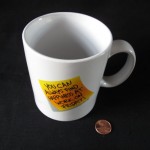[The auction for this MYSTERY Significant Object, with story by Ben Greenman, has ended. Original price: 99 cents. Final price: $103.50. Significant Objects will donate the proceeds of this auction to 826 National.]
This object was the first artifact found at the Hasegawa house in Osaka, Japan, in 2006, immediately following the death of Nobuhiko Hasegawa. The Nobuhiko Hasegawa in question here is, of course, the famed Japanese giant, not the successful table-tennis player of the nineteen-seventies and eighties. Nobuhiko Hasegawa, the giant, claimed a height of seven feet, eleven inches, though spinal deterioration rendered him unable to stand upright from the age of fifteen onward. Since he could not be measured, the title of Tallest Japanese Man was not formally extended to him and was granted instead to Yasutaka Okayama, who stood a relatively modest seven feet, eight inches.
Hasegawa was a man of limited intellect, at best, and he did not have any great investment in—or perhaps even an awareness of—this issue. But there were those around him who believed fiercely that he deserved recognition, just as there were those around Okayama who believed in their man. These self-appointed proxies enjoyed a spirited disagreement regarding this title right up until Hasegawa’s death, at which time a wag in the Okayama camp conceded the seven-foot-eleven-inch height but suggested that it be reduced by six feet to reflect burial. This self-styled wit happened to be British, which should be apparent given the failure of his remark to take into account Japanese burial practices, in which the body is cremated and the ashes placed in a shallow mairibaka, or grave for visitation. One of the most prominent backers of the Hasegawa claim, the poet Kentaro Nakano, released a statement in response to the Okayama camp’s alleged witticism; it consisted simply of the words “shame” and “dog.”
If Nobuhiko Hasegawa was possibly the tallest man in Japan, he was also possibly the oldest; on his wall, he a framed birth certificate that indicated a birth year of 1876. It recorded, ironically enough, that he had been born in Britain, and specifically in Coventry, where (he would explain if asked, in his glacial baritone) his mother was a cook for the English inventor James Starley. Starley, of course, was the father of modern bicycles, and in 1876, the year of the giant Hasegawa’s birth, he developed one of his most famous inventions: the Coventry Lever Tricycle. The Coventry Lever Tricycle was a vehicular breakthrough; prior to that, all Starley cycles were based on a quadrisected wheel design that, if sufficiently sturdy, proved too heavy and too expensive for mass production. As a very young child, Hasegawa would tell anyone who would listen, he rode nearly every Starley prototype. When, in 1881, Hasegawa’s mother decided to return to Japan after a quarrel with Starley—there are rumors that she was not in his employ, but rather his lover, and even rumors that Starley was Hasegawa’s true father—young Nobuhiko said farewell to this idyllic existence in Coventry. Within a decade, he would be confined to a wheelchair as a result of his rapid growth and the attendant spinal issues. “From three wheels to four,” he liked to say, shaking his head sadly. “From three to four.”
To reiterate: This object was the first artifact found at the Hasegawa house in Osaka, Japan, in 2006, immediately following the death of Nobuhiko Hasegawa. A second visit to the house was planned but never carried out; after the insensitive remarks regarding Hasegawa’s burial, the rivalry between the Hasegawa and Okayama camps escalated. The poet Kentaro Nakano was ambushed by a pack of Okayama adherents and defended himself with a glass bottle, blinding one of his attackers. The next day, the Hasegawa house was burned to the ground. This object in question, then, is the only remaining possession of a famed Japanese giant, and it resembles him in contraries: it is as small as he was large, as mobile as he was immobile, as bright as he was dull.







Hmm… something small, mobile, and bright. Any other clues in the story? This is reminding me of the time I cracked the case of the WOOLLETT QUESTION, actually…
http://tinyurl.com/ycqgynf
Pingback: Mystery Object: To be revealed tomorrow | Significant Objects
Pingback: The Mystery Object Revealed! Story-As-Object To Follow | Significant Objects
Pingback: Today: Our first multi-part story — from Kasper Hauser | Significant Objects
Pingback: Significant Objection | Significant Objects
Pingback: Author Updates | Significant Objects